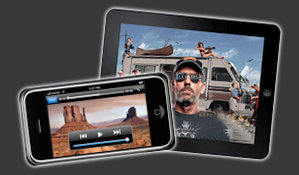



|
F.A.Q.'s
Streaming Video
- WHAT EXACTLY IS "STREAMING
MEDIA"?
-
"Streaming media" refers to listening to
or viewing digital media-mainly audio or video-on your computer in real-time as it
comes across the Internet. In the past, you had to wait up to an hour
to hear or see a few minutes of downloaded audio and video. But with streaming media
you can view content and information instantly-on anything from
an ordinary telephone line to a broadband connection or office
LAN.
- WHAT'S THE
DIFFERENCE BETWEEN "DOWNLOAD-AND-PLAY" VERSUS "REAL-TIME"
STREAMING?
-
Experiencing Internet media via the
download-and-play method means exactly that-your computer downloads a compressed media
file, such as MP3, from the Internet to
your hard drive. Once that file has downloaded completely, the media starts to play.
With real-time streaming, on the other hand, the media
is broadcast directly to your computer from
a server and played back as the information is received from the server. HTTP Streaming
(download-and-play) Also known as
progressive streaming, this method takes a compressed media file and downloads it to
your computer's hard drive before playback using any
Web server such as Apache, Roxen, Microsoft
Internet Information Server or Netscape. Real Time Streaming Real-time streaming is
broadcast to your computer directly
from a server and played back as the information is received from the server, without
waiting for the file to download. Real-time servers
include the
RealSystem Server and QuickTime's Darwin streaming
server.
- WHAT KINDS OF FILES CAN BE
STREAMED?
-
We support widest variety of media types
on our streaming servers. Below is a list of the media types which can be streamed over
our network: RealNetworks: RealAudio
(.rm), RealVideo (.rm, .rmvb), RealPix (.rp), RealText (.rt) Macromedia: Flash (.swf)
Microsoft: Windows Media (.asf, .wma, .wmv) Apple:
QuickTime (.mov) Standards-Based: MPEG-1, MPEG-2, MPEG-4, MP3 Image
Formats: GIF (.gif), JPEG (.jpg, jpeg), PNG (.png) Other: AU (.au), AIFF (.aif,
.ief), WAV (.wav).
- WHAT DO "BROADBAND" AND
"NARROWBAND" MEAN?
-
"Broadband" and "narrowband" are terms
used to describe the type of connection you have to the Internet, based on your
connection speed. Broadband
usually refers to
high-speed connections of 200Kbps or higher (such as DSL or cable-modem connections),
and narrowband refers to connections of less than
200Kbps (e.g., a
regular dial-up modem using your phone
line).
- WHAT ARE
CODECS?
-
Whenever you encode some content, you're
utilizing a codec. "Codec" is an abbreviation for compression/decompression. A codec
can be either a software application or a piece of hardware that processes media through
complex algorithms, which compress the file for streaming and then decompress it
for playback.
Unlike other kinds of file-compression packages that require you to decompress a file
before viewing or listening, codecs decompress the media
on -the-fly,
so your audience can view or listen to a file from its original compressed format. Your
audience sees your content immediately with minimal
loss of quality
from the original.
- HOW CAN I MAKE MY STREAMING
PRESENTATIONS MORE DYNAMIC?
-
Using a technology called SMIL
(Synchronized Multimedia Integration Language, a W3C standard for Web media) you can
combine different media
types-audio, video, text, still images, Flash, etc.-in the order you want
them to appear, and place them where you want them to appear in your player. It's
one thing to simply show a video on the Web, but much cooler when you can
create a fully interactive presentation featuring multiple media types.
Ask
one of our sales representatives about this
today!
- WHAT'S
THE DIFFERENCE BETWEEN SURESTREAM AND SINGLE RATE
ENCODING?
-
These terms apply to RealNetworks' technology
only, however, Windows Media has similar capabilities. Single rate encoding is when the
digital media file that you are
making can be played back at one speed only. This is typically used if you will
be streaming from a web server rather than from a media
server. This type of encoding has drawbacks. For
instance, if you encode the file at a high speed, and the user is connected to
the Internet at 56k, the media file will not
'stream' to the users computer. Playback, if at all, will have long delays while
the video frames are downloaded to the users computer. As soon
as enough frames are downloaded to show a
smooth picture, the file is played. SureStream technology enables you to encode
your material in multiple speeds within one
file. This is the best method to use if you want to provide the highest quality
video to your users. When a user clicks on the link to play
the video, RealServer G2 will automatically
negotiate the connection speed to the user and supply the correct speed for them.
When using the SureStream option to encode
files it is best not to select to many speeds as the file size grows very
quickly. Two or three speeds are
reasonable.
- DO I NEED TO ENCODE MY OWN
FILES?
-
No. SurfNet has a full media center
dedicated only to media creation and encoding. While anyone could purchase a low-end
video capture board and
input source
to encode media there are many more factors to consider especially in delivering
the highest quality media. To produce the best frame
playback requires the highest quality of editing/playback decks, high end
capture cards and experienced media engineers to piece it all together. If you
have the capabilities in house to do this then by all means we suggest
that you can, should your time and resources allow for
it.
- IF I DECIDE TO ENCODE MY OWN
FILES, HOW DO I UPLOAD MY ENCODED FILES TO YOUR
SERVER?
- HOW DO I LINK FROM MY WEB SITE TO
MY VIDEO FILES?
- WHAT DOES 56K, 100K AND 300K
MEAN?
-
These numbers represent the streaming
video file that is associated with an individual's Internet speed. If you have a 56K
(most common), you would click
on a
video clip that has a "56K" associated with it. Higher connections, such as DSL,
are typically 100K and above. Bottom line, the faster your
Internet connection, the higher quality of video you will be able to
watch instantaneously.
- CAN I TELL WHO HAS BEEN WATCHING
STREAMING VIDEO ON OUR SITE?
- I ALREADY HAVE A GREAT
RELATIONSHIP WITH OUR WEB DESIGNERS/HOSTS, HOW CAN WE WORK
TOGETHER?
-
Our service is designed to add value and
compliment your existing web activity. Although we are a full service provide with our
own hosting services our clients are not obligated to use “all” our product offerings. Clients
can mix and match which services they wish to use of ours and which services they
wish to use
elsewhere. In this case, we work alongside your existing web designers/hosts to show
them how to place the appropriate link to replay your video.
In reality
this is quite simple and just requires a brief phone call or e-mail to get this
going.
|

